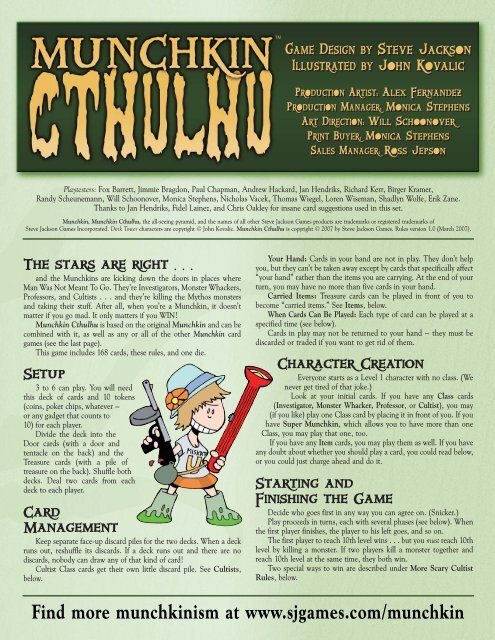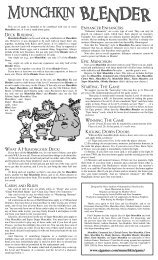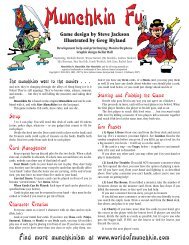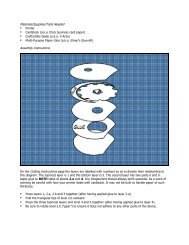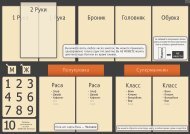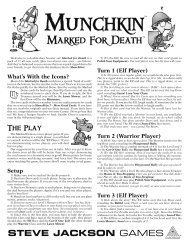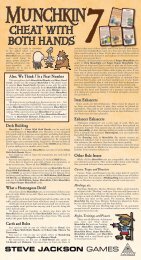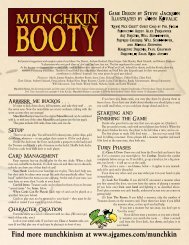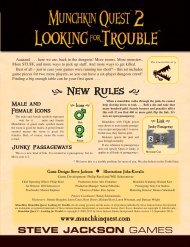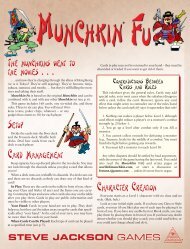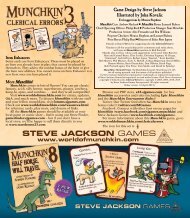Create successful ePaper yourself
Turn your PDF publications into a flip-book with our unique Google optimized e-Paper software.
GAME DESIGN BY STEVE JACKSON<br />
ILLUSTRATED BY JOHN KOVALIC<br />
PRODUCTION ARTIST: ALEX FERNANDEZ<br />
PRODUCTION MANAGER: MONICA STEPHENS<br />
ART DIRECTION: WILL SCHOONOVER<br />
PRINT BUYER: MONICA STEPHENS<br />
SALES MANAGER: ROSS JEPSON<br />
Playtesters: Fox Barrett, Jimmie Bragdon, Paul Chapman, Andrew Hackard, Jan Hendriks, Richard Kerr, Birger Kramer,<br />
Randy Scheunemann, Will Schoonover, Monica Stephens, Nicholas Vacek, Thomas Wiegel, Loren Wiseman, Shadlyn Wolfe, Erik Zane.<br />
Thanks to Jan Hendriks, Fidel Lainez, and Chris Oakley for insane card suggestions used in this set.<br />
<strong>Munchkin</strong>, <strong>Munchkin</strong> <strong>Cthulhu</strong>, the all-seeing pyramid, and the names of all other Steve Jackson Games products are trademarks or registered trademarks of<br />
Steve Jackson Games Incorporated. Dork Tower characters are copyright © John Kovalic. <strong>Munchkin</strong> <strong>Cthulhu</strong> is copyright © 2007 by Steve Jackson Games. <strong>Rules</strong> version 1.0 (March 2007).<br />
The stars are right . . .<br />
and the <strong>Munchkin</strong>s are kicking down the doors in places where<br />
Man Was Not Meant To Go. They’re Investigators, Monster Whackers,<br />
Professors, and Cultists . . . and they’re killing the Mythos monsters<br />
and taking their stuff. After all, when you’re a <strong>Munchkin</strong>, it doesn’t<br />
matter if you go mad. It only matters if you WIN!<br />
<strong>Munchkin</strong> <strong>Cthulhu</strong> is based on the original <strong>Munchkin</strong> and can be<br />
combined with it, as well as any or all of the other <strong>Munchkin</strong> card<br />
games (see the last page).<br />
This game includes 168 cards, these rules, and one die.<br />
Setup<br />
3 to 6 can play. You will need<br />
this deck of cards and 10 tokens<br />
(coins, poker chips, whatever –<br />
or any gadget that counts to<br />
10) for each player.<br />
Divide the deck into the<br />
Door cards (with a door and<br />
tentacle on the back) and the<br />
Treasure cards (with a pile of<br />
treasure on the back). Shuffle both<br />
decks. Deal two cards from each<br />
deck to each player.<br />
Card<br />
Management<br />
Keep separate face-up discard piles for the two decks. When a deck<br />
runs out, reshuffle its discards. If a deck runs out and there are no<br />
discards, nobody can draw any of that kind of card!<br />
Cultist Class cards get their own little discard pile. See Cultists,<br />
below.<br />
Your Hand: Cards in your hand are not in play. They don’t help<br />
you, but they can’t be taken away except by cards that specifically affect<br />
“your hand” rather than the items you are carrying. At the end of your<br />
turn, you may have no more than five cards in your hand.<br />
Carried Items: Treasure cards can be played in front of you to<br />
become “carried items.” See Items, below.<br />
When Cards Can Be Played: Each type of card can be played at a<br />
specified time (see below).<br />
Cards in play may not be returned to your hand – they must be<br />
discarded or traded if you want to get rid of them.<br />
Character Creation<br />
Everyone starts as a Level 1 character with no class. (We<br />
never get tired of that joke.)<br />
Look at your initial cards. If you have any Class cards<br />
(Investigator, Monster Whacker, Professor, or Cultist), you may<br />
(if you like) play one Class card by placing it in front of you. If you<br />
have Super <strong>Munchkin</strong>, which allows you to have more than one<br />
Class, you may play that one, too.<br />
If you have any Item cards, you may play them as well. If you have<br />
any doubt about whether you should play a card, you could read below,<br />
or you could just charge ahead and do it.<br />
Starting and<br />
Finishing the Game<br />
Decide who goes first in any way you can agree on. (Snicker.)<br />
Play proceeds in turns, each with several phases (see below). When<br />
the first player finishes, the player to his left goes, and so on.<br />
The first player to reach 10th level wins . . . but you must reach 10th<br />
level by killing a monster. If two players kill a monster together and<br />
reach 10th level at the same time, they both win.<br />
Two special ways to win are described under More Scary Cultist<br />
<strong>Rules</strong>, below.<br />
Find more munchkinism at www.sjgames.com/munchkin
Turn Phases<br />
(1) Open A Door: Draw one card from the Door deck and turn it<br />
face up. If it’s a monster, you must fight it. See Combat. Resolve the<br />
combat completely before you go on. If you kill it, go up a level (or, for<br />
a big monster, two levels – it will say so on the card).<br />
If the card is a curse – see Curses, below – it applies to you immediately<br />
(if it can) and is discarded.<br />
If you draw any other card, you may either put it in your hand or<br />
play it immediately.<br />
(2) Look For Trouble: If you did NOT encounter a monster when<br />
you first opened the door, you now have the option of playing a<br />
monster (if you have one) from your hand and fighting it, as described<br />
above. Don’t play a monster you can’t handle, unless you’re sure you<br />
can count on getting help!<br />
(3) Loot The Room: If you killed a monster, take the number of<br />
Treasures shown on the monster card. Draw them face down if you<br />
killed the monster alone, or face up if you had help.<br />
If you met a monster but ran away, you get no treasure.<br />
If you did not meet a monster, or met one who was friendly to you,<br />
you search the empty room. Draw a second card from the Door deck,<br />
face down, and place it in your hand.<br />
(4) Charity: If you have more than five cards in your hand, give<br />
the excess to the player with the lowest level. If players are tied for lowest,<br />
divide the cards as evenly as possible, but it’s up to you who gets<br />
the bigger half. If YOU are the lowest or tied for lowest, just discard the<br />
excess.<br />
It is now the next player’s turn.<br />
Combat<br />
To fight a monster, check the Level at the top of its card. If your<br />
own Level, plus the Bonus from any items you are carrying, totals more<br />
than the monster’s Level, you kill it. Some monster cards have special<br />
powers which affect combat – a bonus against one class, for instance.<br />
Be sure to check these before resolving combat.<br />
You may also use one-shot cards, such as Ichors or the Piercing<br />
Shriek, from your hand during combat. A card is a one-shot if it says<br />
Usable Once Only or if it gives a level increase.<br />
You cannot trade items while combat is going on.<br />
If other players interfere by adding another monster (a Wandering<br />
Monster or a “goth” monster) to the fight, you must defeat their combined<br />
levels. If you have the right cards, you can eliminate one monster<br />
from the combat and fight the other normally, but you cannot choose<br />
to fight one and run from the other(s). If you eliminate one<br />
with a card but then run from the other(s), you don’t get<br />
any treasure.<br />
If you kill a monster, you automatically go<br />
up a level (two levels for some very dangerous<br />
monsters). If you were fighting multiple<br />
monster cards, you go up a level for<br />
each monster killed! But if you defeat a<br />
monster without killing it, you<br />
NEVER go up a level.<br />
Discard the monster card(s) and<br />
draw treasure (see below). But note:<br />
someone may play a hostile card on<br />
you, or use a special power, just as you<br />
think you have won. When you kill or otherwise defeat a monster, you<br />
must wait a reasonable time, defined as about 2.6 seconds, for anyone<br />
else to speak up. After that, you have really killed the monster, and you<br />
really go up a level and get the treasure, though they can still whine and<br />
argue.<br />
If you cannot defeat the monster, you have two choices: ask for help<br />
or run away.<br />
Asking For Help<br />
You may ask any other player to help you. If he refuses, you may<br />
ask another player, and so on, until they all turn you down or someone<br />
helps. Only one player can help you.<br />
You can bribe someone to help. In fact, you’ll probably have to. You<br />
may offer him any Item(s) you are currently carrying, or any number of<br />
the Treasure cards the monster has. If you offer him part of the treasure,<br />
you must agree whether he picks first, or you pick first, or what.<br />
When someone helps you, add his Level and Bonuses to yours.<br />
The special abilities or vulnerabilities of the monster also apply to<br />
your helper, and vice versa. For instance, if you are not an Investigator,<br />
but an Investigator helps you, the Shoggoth will be at a -2 against you.<br />
But if you are facing the Shallow Ones and a Professor helps you, the<br />
foe’s level is increased by 2 (unless you, too, are a Professor and the foe’s<br />
level has already been increased . . . don’t increase it twice).<br />
If someone successfully helps you, the monster is slain. Discard it,<br />
draw treasure (see below), and follow any special instructions on the<br />
monster card. You still go up a level for each slain monster. Your helper<br />
does not go up a level.<br />
If nobody will help you . . . or if somebody tries to help, and the<br />
other players hurt you or help the monster so the two of you still cannot<br />
defeat it . . . you must run away.<br />
Running Away<br />
If you run away, you don’t get any levels or treasure. You don’t even<br />
get to loot the room (that is, draw a face-down Door card). And you<br />
don’t always escape . . .<br />
Roll the die. You only escape on a 5 or better. Some Items make it<br />
easier or harder to run away. And some monsters are fast, and give you<br />
a penalty to your roll.<br />
If you escape, discard the monster. You get no treasure. There are<br />
usually no bad effects . . . but read the card. Some monsters might hurt<br />
you even if you get away from them!<br />
If the monster catches you, it does Bad Stuff to you, as described<br />
on its card. This may vary from losing an item, to losing one or more<br />
levels, to Death.<br />
If two players are cooperating and still can’t defeat the monster(s),<br />
they must both flee. They roll separately. The monster(s) CAN catch<br />
them both.<br />
If you are fleeing from multiple monsters, you roll separately to<br />
escape each one, in any order you choose, and suffer Bad Stuff from<br />
each one that catches you as soon as it catches you.<br />
Death<br />
If you die, you lose all your stuff. You keep your<br />
class(es) and level – your new character will look just<br />
like your old one.<br />
Looting The Body: Lay out your hand beside<br />
the items you had in play. (Enhancer cards played<br />
on a Cultist are simply discarded if the Cultist<br />
dies.) Starting with the one with the highest level,<br />
each other player chooses one card . . . in case of ties<br />
in level, roll a die. If your corpse runs out of cards,<br />
tough. After everyone gets one card, the rest are<br />
discarded.<br />
Your new character appears immediately and can help<br />
others in combat on the next turn . . . but you have no cards.
On your next turn, start by drawing two from each deck, face-down,<br />
and playing any Class or Item cards you want to, just as when you<br />
started the game.<br />
Treasure<br />
When you kill a monster, you get its treasure. Each monster has a<br />
Treasure number on the bottom of its card. Draw that many treasures.<br />
Draw face-down if you killed the monster alone. Draw face-up, so the<br />
whole party can see what you got, if someone helped you.<br />
Treasure cards can be played as soon as you get them. Item cards<br />
can be placed in front of you. “Go Up A Level” cards can be used<br />
instantly.<br />
Character Stats<br />
Each character is basically a collection of weapons, armor, and<br />
gadgets, with two stats: Level and Class. For instance, you might<br />
describe your character as “a 9th-level Investigator with a Slime-Proof<br />
Poncho, a Fake Tentacle, and a Backpack Full of Dynamite.”<br />
Your character’s sex starts off the same as your own.<br />
Level: This is a measure of how generally buff and studly you are.<br />
(Monsters have levels, too.) Keep track of your level by placing tokens<br />
in front of you. Level ranges from 1 to 10. You will gain and lose levels<br />
constantly during play.<br />
You gain a level when you kill a monster, or when a card says that<br />
you do. You can also sell items to buy levels (see Items).<br />
You lose a level when a card says that you do. Your level can never<br />
go below 1. However, your effective level in a combat can be negative,<br />
if enough bad cards are played on you.<br />
Class: Characters may be Professors, Investigators, Monster<br />
Whackers, or Cultists, with the appropriate Class card. Each class has<br />
different abilities, shown on the cards. You gain the abilities of a class<br />
the moment you play its card in front of you, and lose them as soon as<br />
you lose or discard that card.<br />
Some class abilities are powered by discards. You may discard any<br />
card, in play or in your hand, to power a special ability. Note that if you<br />
have NO cards in your hand, you cannot “discard your whole hand.”<br />
You can discard a Class card at any time, even in combat: “I don’t<br />
wanna be a Professor any more.” Exception: you cannot discard the<br />
Cultist card voluntarily. See Cultists, below.<br />
You may not belong to more than one class at once unless you play<br />
the Super <strong>Munchkin</strong> card.<br />
Cultists<br />
You cannot voluntarily discard this class! You can still lose it<br />
because of cards played by yourself or others, but you can never just say<br />
“I don’t want to be a Cultist any more.” It’s not that easy to quit . . .<br />
When you discard a Cultist card for any reason, put it in a separate<br />
discard pile, not in the regular Door discards, and do not count this pile<br />
as “discards” for any other purpose, because:<br />
If any card tells you “Become a Cultist,” and there is a discarded<br />
Cultist card waiting for you, then you must take it. If there is no Cultist<br />
card, you escaped . . . this time. If you were already a Cultist, there is<br />
no further effect; you don’t take another card.<br />
There are six Cultist cards in the deck – more than any other class<br />
– and several cards have special effects for Cultists. Don’t be surprised<br />
if the game ends with most or all of the players as Cultists!<br />
More Scary Cultist <strong>Rules</strong><br />
If there is only ONE Cultist, then nothing can make him lose his<br />
Class except Divine Intervention . . . which is not in this set. (But yes,<br />
Divine Intervention will cure everyone of Cultishness if it is played.)<br />
If all the players become Cultists but one, the non-Cultist player<br />
gets a level, and this can be the winning level.<br />
If ALL the players become Cultists, the game ends, and victory goes<br />
to the player(s) with the highest level.<br />
Items<br />
Each Item card has a name, a power, and a value in gold pieces.<br />
An Item card in your hand does not count until you play it; at that<br />
point, it is “carried.” You may carry any number of items.<br />
Some items have special use restrictions. For instance, the<br />
Necronomicon can only be wielded by a Professor. Its bonus only<br />
counts for someone who is, at the moment, a Professor.<br />
You may also use only one headgear, one item of armor, one set of<br />
footgear, and two “hand” items (or one “two hands” item), unless you<br />
have cards or special abilities that let you use more or the other players<br />
don’t catch you. If you are carrying two “headgear” items, for instance,<br />
only one of them can help you.<br />
You should indicate items that can’t help you, or extras<br />
not being worn, by turning the cards sideways. You may<br />
NOT switch items during a combat or<br />
while running away.<br />
Selling Items: During<br />
your turn, you may discard<br />
items worth 1,000 gold<br />
pieces and immediately go up<br />
one level. If you discard (for<br />
instance) 1,100 gold pieces worth,<br />
you don’t get change. But if you can<br />
manage 2,000 worth, you can go up two levels at once, and so on. You<br />
may discard items from your hand as well as those you are carrying.<br />
You may not sell, trade, or steal items DURING a fight. Once you<br />
expose a monster card, you must finish the fight with the cards you<br />
have.<br />
When to Play Cards<br />
Instructions on the cards always override the general rules.<br />
However, no card can reduce a player or monster to Level 0 or below,<br />
and no player can reach Level 10 except by killing a monster.<br />
Monsters<br />
If drawn face-up, during the “Open A Door” phase, monster cards<br />
apply to the person who drew them. They must be fought immediately.<br />
If acquired any other way, they may be played during “Looking For<br />
Trouble,” or played on another player with the Wandering Monster card.<br />
For rules purposes, each Monster card is a single monster, even if<br />
the name on the card is plural.<br />
Monster Enhancers<br />
“Indescribably Horrible” and similar “enhancer” cards raise the<br />
level of monsters (and “In A Million-Year Sleep” lowers the level).<br />
“Wandering Monster” brings another monster to join a battle. They<br />
may be played during any combat.<br />
All enhancers add together. If Indescribably Horrible, Gibbering,<br />
and Four-Dimensional are played together, in any order, you are facing a<br />
gibbering, indescribably horrible, four-dimensional monster. However,<br />
if there are multiple monsters in the combat, the player who plays the<br />
enhancer must choose which one it applies to.<br />
Treasures – Playing Them<br />
Most Treasure cards are items. Items either have a value or say<br />
“No Value.” Items may be played to the table as soon as you get them,<br />
or at any time during your own turn.
Some Treasure cards are “specials” (like “Go Up A Level”). You<br />
may use these at any time, unless the card itself says otherwise. Follow<br />
its instructions; then discard it.<br />
Treasures – Using Them<br />
Any one-shot (“usable once only”) card can be played during any<br />
combat, whether you have it in your hand or on the table.<br />
Other items cannot be used unless they are in play. If it’s your turn,<br />
you can play them and use them immediately. If you are helping someone,<br />
or fighting out of turn for some reason, you cannot play new items<br />
from your hand to the table.<br />
Curses<br />
If drawn face-up, during the “Open A Door” phase, Curse cards<br />
apply to the person who drew them.<br />
If drawn face-down or acquired some other way, they may be played<br />
on ANY player at ANY time. Reducing someone’s abilities just as he<br />
thinks he has killed a monster is a lot of fun.<br />
A curse affects its victim immediately (if it can) and is discarded.<br />
Exception: “Change Sex” gives a penalty on your next fight. If you’re not<br />
in a fight when it is played on you, keep the card until your next fight<br />
as a reminder.<br />
If a curse can apply to more than one item, the victim decides<br />
which item is lost or changed.<br />
If a curse applies to something you don’t have, ignore it. For<br />
instance, if you draw “Lose Your Headgear” and you have no headgear,<br />
nothing happens; discard the curse.<br />
Classes<br />
These cards may be played to the table as soon as they are acquired,<br />
or at any time during your own turn.<br />
Super <strong>Munchkin</strong><br />
This card lets you have two classes.<br />
You can play Super <strong>Munchkin</strong> any time you have one class in<br />
play and you have a second class card to add to it. You now have two<br />
classes, with the advantages and disadvantages of both. You lose Super<br />
<strong>Munchkin</strong> if you lose either of your class cards.<br />
Other <strong>Munchkin</strong> Stuff<br />
There will be times when it will help you to play a Curse or Monster<br />
on yourself, or to “help” another player in a way that costs him treasure.<br />
This is very munchkinly. Do it.<br />
Trading<br />
You may trade Items (but not other cards) with other players. You<br />
may only trade items from the table – not from your hand. You may<br />
trade at any time except when you’re in combat . . . in fact, the best<br />
time to trade is when it’s not your turn. Any item you receive in a trade<br />
must go to the table; you can’t sell it until it’s your turn.<br />
Faster Play<br />
For a quicker game, each player starts with four cards from<br />
each deck, and gets four from each deck when he returns from<br />
death.<br />
Any time a Race, Class, Super <strong>Munchkin</strong>, or Half-Breed card<br />
is on top of the discard pile, any player may discard a “Go Up A<br />
Level” card from his hand and claim it. If multiple players try to<br />
claim a card, they roll dice. The winner gets it; the loser keeps his<br />
Level card.<br />
You may also give items away without a trade, to bribe other players<br />
– “I’ll give you the Triple-Barreled Shotgun if you won’t help Bob<br />
fight Great <strong>Cthulhu</strong>!”<br />
You may show your whole hand to other players. Like we could stop<br />
you.<br />
Interfering With Combat<br />
You can interfere with others’ combats in several ways:<br />
Use a one-shot card. If you have an Ichor card, you could help someone<br />
by throwing it at his foe. Of course, you can “accidentally” hit your<br />
friend with the Ichor, and it will count against him.<br />
Play a card to enhance a monster. See Monster Enhancers, above. You can<br />
play these either during your own combats or during someone else’s combat.<br />
Play a wandering monster. This sends a monster from your hand to join<br />
any combat.<br />
Curse them, if you have a Curse card.<br />
“Goth” Monsters<br />
Monsters ending in “goth” have the power to summon other gothy<br />
things. When a “goth” monster appears in a combat, the player who<br />
played or drew it may play one other “goth” monster from his hand into<br />
the combat. If he does not play another “goth,” go around the table,<br />
starting at his left. Each player in turn has one chance to add a single<br />
“goth” to the combat, until one “goth” is played. After one “goth”<br />
joins the original monster, the combat proceeds.<br />
A “goth” that enters the combat this way does not get to bring in<br />
another “goth.” However, a “goth” that enters the combat by means of<br />
a Wandering Monster card, or any other special card or ability, does get<br />
to bring in another “goth,” as described above.<br />
<strong>Cthulhu</strong> Rises!<br />
This set’s Level 20 monster is Great <strong>Cthulhu</strong>. Yes, we already did<br />
Great <strong>Cthulhu</strong> in Star <strong>Munchkin</strong>. What can we say? The stars were<br />
right for his return. And we warn you right now, he’ll be back again.<br />
<strong>Rules</strong> Contradictions or Disputes<br />
When the cards disagree with the rules, follow the cards. Any other<br />
disputes should be settled by loud arguments among the<br />
players, with the owner of the game having the last word.<br />
Combining This Game With<br />
Other <strong>Munchkin</strong> Sets<br />
Go for it! Your Elven Ninja Investigator and Russian Half-Dwarf<br />
Mutant Assassin can strike fear into the hearts of all sorts of<br />
monsters . . .<br />
Shuffle all the Treasure cards together. Shuffle all the Door cards<br />
together. You now have two big decks. If you have enough sets, you<br />
now have two VERY big decks.<br />
Use the “fast play” rules (see box). Note that these rules refer to<br />
some card types that are not in this particular set! Don’t panic.<br />
Traps and Curses are treated as the same kind of card. Any reference<br />
to a Trap also means a Curse and vice versa. Yes, Star <strong>Munchkin</strong><br />
Gadgeteers can “disarm” Curses. Likewise, Credits and Gold Pieces are<br />
the same thing and can be combined to buy levels, pay taxes, and so on.<br />
All characters may have Races, Classes, <strong>Munchkin</strong> Fu Styles, and<br />
<strong>Munchkin</strong> Impossible Training! All at once!<br />
Hirelings, Sidekicks, and <strong>Munchkin</strong> Fu Mooks are all the same<br />
“Hireling” class, and the Mook can sacrifice himself like a<br />
Sidekick/Hireling, but each Hireling can carry items or be enhanced<br />
only as that card says.<br />
Some <strong>Munchkin</strong> <strong>Cthulhu</strong> cards are labeled as “Undead.” There<br />
are no Undead rules in this set; the tag is there so the Clerics from<br />
original <strong>Munchkin</strong> can persecute those monsters.


